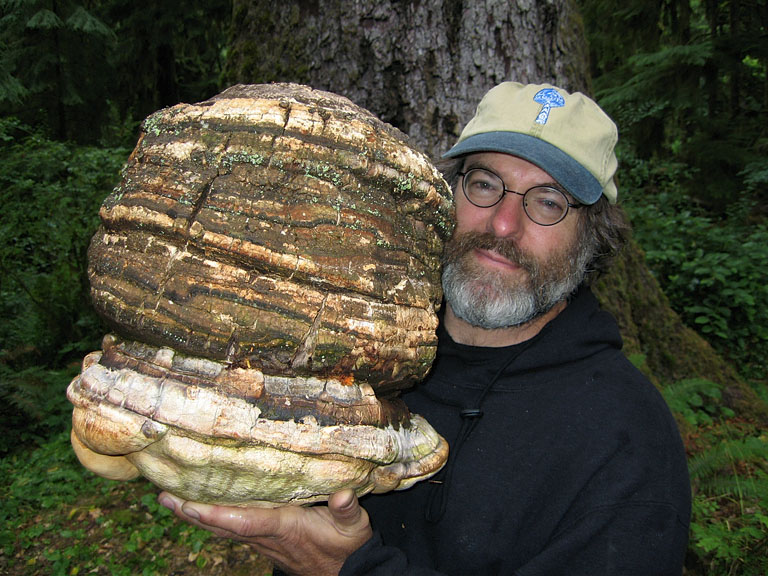Fungi
Laricifomes officinalis (Agarikon)
Laricifomes officinalis is a wood-decay fungus in the order Polyporales. It causes brown heart rot on conifers, and is found in Europe, Asia, and North America, as well as Morocco. It is commonly known as agarikon, as well as the quinine conk due to its extremely bitter taste. DNA analysis supports L. officinalis as being distinct from the genus Fomitopsis. "The decay is common only in a few old-growth stands. The conks were once collected extensively for production of medicinal quinine. These distinctive conks can be large, as much as two feel\t long, hoof-shaped or columnar. They are soft, yellow-white when young, soon becoming white and chalky throughout. The decay is brown, cubically cracked, with thick white felts in large cracks. The taste of both conks and felts is bitter and distinct for this species. A single conk usually indicates complete cull. Infected trees can be habitat for snag-nesting species.
Medicinal Use
Laricifomes officinalis was used by the Ancient Greeks to treat consumption (tuberculosis) according to the writings of Pedanius Dioscorides in 65 AD and by some indigenous people to treat small pox.
Interestingly, the medicinal properties are believed to have been discovered independently by the isolated Indigenous People of North America. In North America, these fungi were referred to as “bread of ghosts” or “tree biscuits,” references to the spiritual powers of the mushroom and its hanging fruiting bodies. The mushroom was an important resource for Shamans, who would apply agarikon powder to cure ailments thought to be caused by supernatural forces.
Conservation
Wild Agarikon is only found in old-growth forests, and grows on conifers, particularly Douglas-fir (Pseudotsuga) and larch (Larix). Conservation of wild populations of L. officinalis is a concern due to loss of ancient forest habitat. Because it is difficult to maintain long-term genetic integrity of laboratory-grown strains, it is necessary to preserve the mushroom in the wild.
In Culture
These fungi were not only utilized for their medicinal properties, but were also valued as spiritual and supernatural objects. The large fruiting body structures were often carved to represent various spiritual figures and spirit catchers, as assumed by the large orifices in the mouth and stomach. These carved figures were often hung from the ceiling of special dance houses of the Shaman to protect the people during rituals. Because of the key role Laricifomes officinalis played in the life of the Shaman, it was only natural that the mystical fungi should accompany him in the afterlife. The sporophores were carved as jewelry, painted or sometimes coated in a protective substance and placed at the head of the shaman’s grave site, to serve as his “grave guardians”. These grave guardians not only protected the shaman’s burial site, but also warned people of the area that the site was occupied by spirits and should never be approached.
Many of these grave guardian artifacts, collected by explorers and archeologists in the late nineteenth century, were originally believed to be made of wood. It was only recently, when investigating wood deterioration in these “wooden” artifacts, scientists realized the grave guardians were in fact a fungus. Fruiting bodies of L. officinalisare perennial: Each year (or so) a new layer of spore-producing tubes grows at the bottom of the conk. In the past, these the tube layers had apparently been mistaken for the annual growth rings of a tree. Microscopic examination of the hymenial layers revealed the fungal origins of the grave guardians. These artifacts can now be found in the collections of several North American museums. As for the great Laricifomes officinalis, although once common throughout most temperate regions of the world, it is now believed extinct in most of Europe and Asia. However, it can still be found deep within the old-growth forests of Washington, Oregon and British Columbia in the Pacific Northwest, and modern-day mycophiles continue to stress the importance of this valuable and historic polypore.
References
Stamets P. 2006. Antiviral activity from medicinal mushrooms. U.S. Patent 2006/0171958 A1, filed March 22, 2006.
Grzywnowicz K. 2001. Medicinal mushrooms in Polish folk medicine. Internation Journal of Medicinal Mushrooms.
Blanchette R.A., Compton B.D., Turner N.J., Gilbertson R.L. 1992. Nineteenth century shaman grave guardians are carved Fomitopsis officinalis sporophores.
Hagle, Gibson, Tunnock; A Field Guide to Diseases & Insect Pests of Northern & Central Rocky Mountain Conifers 2003





